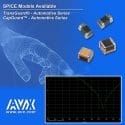source: AVX news
FOUNTAIN INN, S.C. (July 10, 2017) – AVX Corporation, a leading manufacturer and supplier of passive components and interconnect solutions, has released new SPICE models for its CapGuard™ Automotive and TransGuard® Automotive Series multilayer varistors.
Designed to enable shorter, more cost-effective development cycles with more first-pass prototype successes, SPICE models allow electronic design engineers to quickly, easily, and effectively evaluate the integrity of circuit designs, accurately simulate their performance, and identify and correct potentially problematic properties, including parasitic resistances and capacitances.
“The new SPICE models for our TransGuard and CapGuard Automotive Series varistors allow engineers to accurately estimate the performance of these parts in their circuits without waiting for a physical sample to arrive and also allow them to quickly swap out similar components to fine-tune circuits prior to specification, which is especially important in the quality- and cost-conscious automotive designs that these components are designed for,” said Colin Leath, field applications engineer at AVX.
AVX’s surface-mount CapGuard Automotive Series combines multilayer varistor (MLV) and high-capacitance, temperature-stable, X7R multilayer ceramic capacitor (MLCC) technology in a single, high-reliability device that exhibits bi-directional transient voltage protection, excellent EMI/RFI attenuation over a wide frequency spectrum, and multiple-strike capabilities. Qualified to AEC-Q200, CapGuard varistors feature a compact form factor especially designed to preserve board space, exhibit exceptional current and energy handling capabilities, and are ideally suited to protect sensitive electronics from high-voltage transients, as well as to filter out high-frequency EMI/RFI noise generated by switch mode power supplies, motors on DC lines, I/O lines in electronic circuits, inductive switching, relays, and other applications.
AVX’s surface-mount TransGuard Automotive Series is comprised of zinc-oxide-based ceramic semiconductor devices with non-linear, bi-directional voltage-current (V–I) characteristics similar to those of back-to-back Zener diodes. TransGuard varistors provide bi-directional overvoltage protection and EMI/RFI attenuation in a single, small SMT package, as well as exhibit high current and energy handling capabilities, sub 1nS response times to ESD strikes, multiple-strike capabilities, high reliability performance, and high energy absorption/load dump. Qualified to AEC-Q200, the series is ideal for use in commercial and passenger vehicles with internal combustion and hybrid electric engines.
The new SPICE models for AVX’s CapGuard Automotive and TransGuard Automotive Series varistors are compatible with any text-based SPICE simulator and are available for download, free of charge, on AVX’s Design Tools page.






























